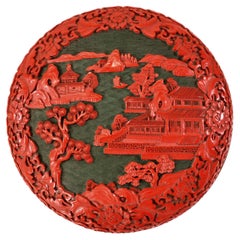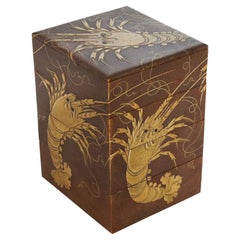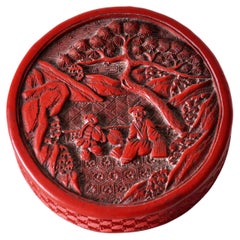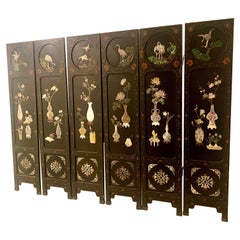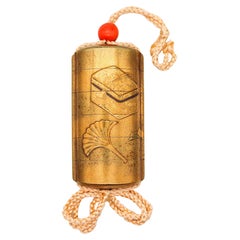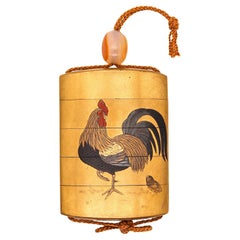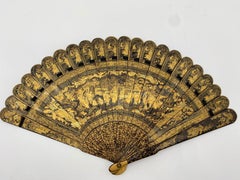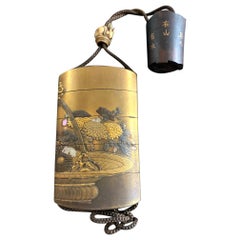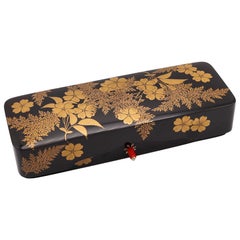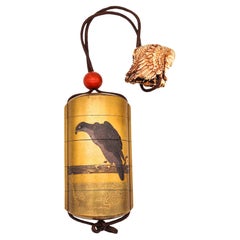Miami - Lacquer
to
3
379
152
16
7
9
5
3
1
1
1
1
13
8
5
4
3
16
11
6
5
5
16
16
16
Item Ships From: Miami
Large Domed Chinese Cinnabar Box
Located in Miami, FL
A large vintage Chinese red cinnabar box with deep relief carved lid depicting peonies, trees and a landscape with a palace. The round box has...
Category
1930s Chinese Chinese Export Vintage Miami - Lacquer
Materials
Brass
JAPAN Meiji Period 1870 Four Tiers Presentation Jubako Box Namiki Lacquer & Gold
Located in Miami, FL
Four Tier Japanese Gilt Jubako Maki-E box with red Interior.
This is a beautiful decorative presentation Jubako box created in the Imperial Japan during the early Meiji period (1868...
Category
1870s Japanese Meiji Antique Miami - Lacquer
Materials
Gold
$4,360 Sale Price / set
20% Off
Antique Chinese Cinnabar Box
Located in Miami, FL
A fine antique Chinese red cinnabar lacquer lidded round box carved with a scene with a young boy and a seated elderly bearded sage within a rocky landscape with trees. The "dragon's...
Category
19th Century Chinese Qing Antique Miami - Lacquer
Materials
Lacquer
Chinese Soapstone, Semiprecious Hardstone and Lacquer Folding Screen
Located in Miami, FL
This stunning Chinese screen is an exceptionally well-crafted piece, beautifully decorated with intricate semiprecious hardstone carvings. Measuring ...
Category
Mid-20th Century Chinese Chinese Export Miami - Lacquer
Materials
Precious Stone, Wood
Japan 1800 Edo Period Six Drawer Inro In Lacquered Gilt Wood With Utensils
Located in Miami, FL
Japanese Inro from the Edo Period (1603-1867).
Beautiful Inro, created in Japan during the Edo period (Shogunate), circa 1800. It was carefully crafted in carved precious wood with ...
Category
Early 1800s Japanese Edo Antique Miami - Lacquer
Materials
Coral
$2,600 Sale Price
20% Off
Japan 1810 Kajikawa Edo Period Five Drawer Inro Lacquered Gilt Wood With Rooster
Located in Miami, FL
Japanese Inro from the Edo period (1615-1868) created by Kajikawa.
Beautiful Inro, created in Japan by one of the Kajikawa family during the Edo period (1615-1868), circa 1810. Has been carefully crafted in carved precious wood with applications of gilding maki-e and decorated with Japonism patterns. All dan trays are attached together with a himo cord. The detailed craftsmanship was a true pleasure to behold.
Period: Edo period (1615-1868). Shogunate.
Approximate Date: 1790-1810
Motif: A family of birds consisting of a cockerel, the hen and three chicks.
Drawers: Five.
Shape: Rectangular navette.
Technique: Carved wood, lacquer and decorated in iroe-hiramaki-e on a gold ground.
Ojime: 15mm 20mm, oval carved from natural translucent agate.
Netsuke: None
Weight: 47.70 Grams.
Measurements: Inro is 78 mm by 55 mm by 18 mm (3.07 x 2.17 x 0.71 Inches).
Signatures: Kajikawa Saku, in the underside with the signature KAJIKAWA. By a member of the Kajikawa family, signed Kajikawa 梶川 Japan, late 18th century to early 19th century, Edo period (1615-1868).
The Kajikawa family
Kajikawa family, flourished in the 19th century, they was Japanese lacquerware artists whose school in Edo (now Tokyo) flourished for more than 200 years. This family is perhaps the most famous of all the dynasties of Japanese lacquer artists, and certainly the name most often found on inro. The family is said to have been founded by Hikobei at Edo in the early 17th century, although some claim that the family’s great reputation really stemmed from his son and pupil Kyujiro. In any event, Hikobei worked for the shogunate, as did his successors until well into the 19th century. Kijirō excelled in designing particularly delicate lacquer inrō, portable medicine cases...
Category
1810s Japanese Edo Antique Miami - Lacquer
Materials
Agate, Gold
$3,560 Sale Price
20% Off
Japan 1870 Meiji Period Round Five Drawer Inro Lacquered Wood With Flying Cranes
Located in Miami, FL
Japanese Inro from the Meiji Period (1868-1912).
Beautiful Inro, created in Japan during the Meiji imperial period, circa 1870. It was carefully crafted in carved precious wood with applications of lacquer and decorated with orientalism patterns. All dan trays are attached together with a himo cord. The detailed craftsmanship was a true pleasure to behold.
Period: Meiji 1868-1912, Period of Emperor Mutsuhito.
Approximate Date: 1870.
Motif: Organic design with cascade landscape scene and five flying cranes.
Drawers: Five.
Shape: Cylinder. Very unusual and rare shape.
Technique: Carved wood, Lacquer, hiramaki-e, takamaki-e, Gilding.
Ojime: 17mm, round with Ebony wood.
Netsuke: Carved dressed...
Category
1870s Japanese Meiji Antique Miami - Lacquer
Materials
Wood, Ebony, Giltwood, Lacquer
Antique Chinese Cinnabar, Brass and Enamel Box
Located in Miami, FL
A crisply carved antique Chinese red cinnabar lacquer lidded round box with blue enamel interior and brass fittings. The "dragon's blood" trinket box has a fine peony, foliate and fl...
Category
19th Century Chinese Qing Antique Miami - Lacquer
Materials
Brass, Enamel
Early 20th Century Burmese Lacquered Tray, “Pagan Bya”
Located in Atlanta, GA
Burmese (Myanmar) Lacquerware has a long tradition dating back to the 13th century. Lacquer in Burma is called “Thitsi” meaning the sap of a Thitsi Tree (Melanhorrea Usitata). Typica...
Category
Early 20th Century Burmese Miami - Lacquer
Materials
Bamboo, Lacquer
Early 20th Century Burmese Lacquered Tray, “Pagan Bya”
Located in Atlanta, GA
Burmese (Myanmar) Lacquerware has a long tradition dating back to the 13th century. Lacquer in Burma is called “Thitsi” meaning the sap of a Thitsi Tree (Melanhorrea Usitata). Typica...
Category
Early 20th Century Burmese Miami - Lacquer
Materials
Bamboo, Lacquer
JAPAN 1900 Meiji Period Fubako Box In Hiramaki-e Lacquered Wood With Gilding
Located in Miami, FL
Fubako letters-box from the Japanese Meiji period (1868-1912).
Beautiful decorative Fubako letters box from the Japanese Imperial Meiji period, circa 1900. This box has been meticul...
Category
Early 1900s Japanese Meiji Antique Miami - Lacquer
Materials
Gold
Early 20th Century Burmese Lacquer Offering Vessel, Hsun Ok
Located in Atlanta, GA
Burmese (Myanmar) lacquer ware has a long tradition dating back to the 13th century. Lacquer in Burma is called “Thitsi” meaning the sap of a Thitsi Tree (Melanhorrea Usitata). Typically, bamboo and wood are used as a frame or base in making lacquer work.
This covered offering vessel is called a “Hsun Ok...
Category
1920s Burmese Vintage Miami - Lacquer
Materials
Wood, Lacquer
JAPAN 1880 Meiji Period Tebako Box In Red Lacquered Wood With Abalone Inlaid
Located in Miami, FL
Presentation Tebako box from the Japanese Meiji period (1868-1912).
Beautiful decorative presentation Tebako box from the Japanese Imperial Meiji period, circa 1880. This box has been meticulously crafted in a squared cushioned shape in wood with kara coating Kobayashi red lacquer, gilding, black lacquer and inlaid decorations of abalone shell, Raden. Tebako literally means "portable box", it is a toilet box containing the objects necessary for washing and make-up, especially blush mirror...
Category
1880s Japanese Meiji Antique Miami - Lacquer
Materials
Abalone, Wool, Lacquer
Early 20th Century, Large Burmese Betel Box, “Kun It”
Located in Atlanta, GA
Burmese (Myanmar) Lacquerware has a long tradition dating back to the 13th Century. Lacquer in Burma is called “Thitsi” meaning the sap of a Thitsi Tree (Melanhorrea Usitata). Typica...
Category
Early 20th Century Burmese Miami - Lacquer
Materials
Bamboo, Lacquer
Large Asian Black Lacquer Gilt Wood "Bird" Charger on Stand, Hand Painted
Located in Miami, FL
Large Asian Black Lacquer Gilt Wood "Bird" Charger on Stand, Hand Painted
Offered for sale is a large Asian hand-painted gilt-decorated charger on a stand depicting birds and foliag...
Category
Late 20th Century Chinese Chinoiserie Miami - Lacquer
Materials
Wood, Lacquer
Early 20th Century Burmese Lacquered Tray Stand, “Dang lan”
Located in Atlanta, GA
Burmese (Myanmar) lacquer ware has a long tradition dating back to the 13th century. Lacquer in Burma is called “Thitsi” meaning the sap of a Thitsi Tree (Melanhorrea Usitata). Typically, bamboo and wood are used as a frame or base in making lacquer work.
This table tray stand called a “Dang lan” and is used to hold dishes...
Category
Mid-20th Century Burmese Miami - Lacquer
Materials
Bamboo, Lacquer
Related Items
Antique Chinese Hand Painted Lacquer Scene Gilt Fan with Lacquer Box
Located in Brea, CA
19th century antique Chinese hand painted lacquer scene gilt fan with original lacquer box.
Category
1830s Chinese Qing Antique Miami - Lacquer
Materials
Lacquer
Antique Japanese Inro by Shigehide Edo Period
Located in Atlanta, GA
This exquisite four-case lacquered inro was dated to the latter part of 18th century to early 19th century (Edo period) and made by Shigehide. The opposite sides of the inro together features a lavish flower arrangement in a bamboo basket (ikebana). The detailed craftmanship was a true pleasure to behold. Mostly Takamaki-e (high relief) were used to texturize the delicate petals of the chrysanthemums, on which different shades of gold were used to create contrast. Raden (mother of pearl) shells were also used to highlight some leaves, rendering the piece an interesting balance of color and material. The interior was completed in a mottled gold finish. It was signed Shigehide on the bottom with a Kao. There is a small carved rabbit ojime bead...
Category
Late 18th Century Japanese Japonisme Antique Miami - Lacquer
Materials
Wood, Lacquer
Japanese Marquetry and Lacquer Jewelry Chest, Meiji Period, circa 1900, Japan
Located in Austin, TX
A very attractive Japanese wood table top jewelry or collector's chest with marquetry and lacquer decoration, Meiji period, circa 1900, Japan. Previously in the collection of Asbjorn Lunde (1927 - 2017).
The chest is crafted in the form of a Chinese seal...
Category
Early 1900s Japanese Meiji Antique Miami - Lacquer
Materials
Wood, Softwood, Lacquer
$3,400
H 15.75 in W 14.25 in D 7 in
Chinese Export Four Panel Carved Soapstone Coromandel Screen
Located in Rio Vista, CA
Impressive Chinese export four panel lacquered coromandel screen featuring hand-carved soapstone beauties in a floral landscape with gilt clo...
Category
20th Century Chinese Chinese Export Miami - Lacquer
Materials
Soapstone, Brass
Japanese Maki-e Lacquer Stacking Box, Jubako, Meiji Period, Japan
Located in Austin, TX
A fine and impressive Japanese gold maki-e decorated black lacquer five-tier jubako with presentation tray, two lids, and the original tomobako storage box, Meiji period, late 19th c...
Category
Late 19th Century Japanese Meiji Antique Miami - Lacquer
Materials
Lacquer
Small Japanese Lacquer Duck Incense Box, Kogo, Meiji Period, Late 19th Century
Located in Austin, TX
An exquisite Japanese Meiji Period small lacquer incense box, kogo, in the form of a duck or goose, late 19th century, Japan.
The delicate lacquer box, known as a kogo in Japanese, ...
Category
Late 19th Century Japanese Meiji Antique Miami - Lacquer
Materials
Lacquer
$2,900
H 1.5 in W 2.88 in D 1 in
Post Qing Dynasty Cinnabar Ginger Jar & Stand
Located in West Palm Beach, FL
Post Qing Dynasty Cinnabar ginger jar & stand
Exquisite high relief carved continuous landscape motif, complete with hardwood stand. Unmarked.
T...
Category
Early 20th Century Chinese Chinese Export Miami - Lacquer
Materials
Hardwood, Lacquer
Vintage Four Panel Lacquer and Carved Hardstone Screen
Located in Vancouver, British Columbia
An early 20th century Asian black lacquer screen with carved coloured hardstone figures and scenery.
Category
1950s French Chinoiserie Vintage Miami - Lacquer
Materials
Stone
$3,960 Sale Price
20% Off
H 48 in W 48 in D 1 in
Japanese Lacquer Smoking Box, Tabako Bon, Edo Period, 19th Century
Located in Austin, TX
A very fine Japanese maki-e lacquer decorated tabako bon, or smoking box, late Edo Period, mid-19th century, Japan.
The elegant smoking box of black lacquer decorated with a wonderful gold lacquer takamaki-e design of a gnarled and elegantly twisted plum tree with branches in full bloom. A border of golden cranes in flight to the top.
The smoking box, called a tabako bon, is comprised of an open section at the top with inset with two cylindrical metal canisters...
Category
Mid-19th Century Japanese Edo Antique Miami - Lacquer
Materials
Lacquer
Fine Japanese Lacquered Inro with Inlays by Kajikawa
Located in Atlanta, GA
A Japanese four-case lacquer inro by a member of Kajikawa family circa 19th century (late Edo to early Meiji period). It depicts a nocturnal scenery of a meandering stream surrounded by bush clovers, where a full moon is reflected on the water. It was masterfully decorated in gold and silver maki-e using a combination of techniques including takamakie, togidashi and kirigane as well as aogai (abalone shell) inlays. The stream was set between the slightly elevated banks, adding to this piece a already strong three-dimensional composition. The interior was decorated in gold nashiji. It was signed on the bottom "Kajikawa Zou" (made by Kajikawa and a pot seal centered with "Ei" in Kanji. In one of the compartment, there is a katakana mark, appears to be a name, possibly the owner.
Kajikawa clan was one of the most famous lacquer artisanal family established in the 17th century. Many well known members over the generations produced lacquer art in a wide range of formats, but two third were signed only with the family name such as this one. It is therefore not possible to pinpoint the exact author of this piece.
Provenance: This inro was purchased as lot 349 in Christie's New York sale Japanese...
Category
19th Century Japanese Japonisme Antique Miami - Lacquer
Materials
Shell, Wood, Lacquer
Chinese Export Four Panel Carved Soapstone Lacquered Screen
Located in Rio Vista, CA
Distinctive Chinese export four-panel coromandel screen featuring carved hardstone and soapstone decoration. The screen depicts a group of beauties in colorful flowing robes. The parcel-gilt landscape is decorated with two large carved stone trees...
Category
20th Century Chinese Chinese Export Miami - Lacquer
Materials
Soapstone, Brass
Japanese Rinpa Style Lacquer Box Meiji Period
Located in Atlanta, GA
A black lacquer tebako (hand box) with maki-e decoration and silver trim, circa late 19th century, Meiji period. The surface of the lid features a Rinpa style maki-e paint depicting ...
Category
1890s Japanese Japonisme Antique Miami - Lacquer
Materials
Wood, Lacquer
Previously Available Items
JAPAN 1900 Meiji Fubako Box In Hiramaki-e Lacquered Black Wood With Gilding
Located in Miami, FL
Fubako letters-box from the Japanese Meiji period (1868-1912).
Beautiful decorative Fubako letters box from the Japanese Imperial Meiji period, circa 1900. This box has been meticulously crafted in wood with black lacquer and gilding decorations. The long sides are attached with a pair of carvings in coral and gilded sterling silver screws.
Created in an elongated rectangular shape with sharp corners, the outside of the lid has decorations in hiramaki-e depicting decorations of Sakura cherry blossom flowers in high relief. The interior part of the lid and the inside of the lower box are fundame lacquered with applications of very fine gold powder.
The Meiji Imperial Period
This is an era of Japanese history that extended from October 23, 1868 to July 30, 1912.The Meiji era was the first half of the Empire of Japan, when the Japanese people moved from being an isolated feudal society at risk of colonization by Western powers to the new paradigm of a modern, industrialized nation state and emergent great power, influenced by Western scientific, technological, philosophical, political, legal, and aesthetic ideas. As a result of such wholesale adoption of radically different ideas, the changes to Japan were profound, and affected its social structure, internal politics, economy, military, and foreign relations. The period corresponded to the reign of Emperor Meiji. It was preceded by the Keiō era and was succeeded by the Taishō era, upon the accession of Emperor Taishō.
Fubako
This is a kind of box. It has been used to store letters, papers, or books, and it is also used to deliver documents to the other party. It is useful not only to store documents or books, but you can also put your favorite small articles or valuables. Or, you can also display it to enjoy as a part of the interior decoration in your room.
Hiramaki-e
This term is in reference to a Japanese lacquer work, gold decoration in low, or “flat,” relief, a basic form of Makie-e. The pattern is first outlined on a sheet of paper with brush and ink. It is then traced on the reverse side of the paper with a mixture of heated wet lacquer and (usually red) pigment. The artist transfers the pattern directly to the desired surface by rubbing with the fingertips, a process called okime. In the next step (jigaki), the pattern that has been transferred is painted over with lacquer—usually a reddish colour. A dusting tube is used to sprinkle gold powder on the painted design while the lacquer is still wet.
Makie-e
This is another more complicated technique of Japanese lacquer art...
Category
Early 1900s Japanese Meiji Antique Miami - Lacquer
Materials
Gold
H 1.75 in W 9.31 in D 3.52 in
Japan 1810 Edo Period Takamaki-e Five Drawer Inro In Lacquered Wood With A Hawk
Located in Miami, FL
Japanese Inro with a Hawk from the Edo Period (1603-1867).
Beautiful Inro, created in Japan during the Edo period (Shogunate), circa 1810. It was carefully crafted in carved preciou...
Category
1810s Japanese Edo Antique Miami - Lacquer
Materials
Coral, Silver
H 3.5 in W 1.62 in D 1.5 in
Japan 1830 Edo Period Six Drawer Inro In Lacquered Gilt Wood With A Carriage
Located in Miami, FL
Japanese Inro from the Edo Period (1603-1867).
Beautiful Inro, created in Japan during the Edo period (Shogunate), circa 1830. It was carefully crafted in carved precious wood with applications of lacquer and decorated with orientalism patterns. All dan trays are attached together with a himo cord. The detailed craftsmanship was a true pleasure to behold.
Period: Edo 1606-1867, Shogunate.
Approximate Date: 1830
Motif: An elaborated three-dimensional royal carriage with a silvered bull and a richly dressed court companion. All surrounded by a road and sinuous mountainous landscape with trees and plants.
Drawers: Six.
Shape: Oval
Technique: Carved wood, Lacquer, hiramaki-e, takamaki-e, Gilding, Silvered.
Ojime: 15mm, round sphere carved from natural translucent carnelian
Netsuke: Patinated carved seated child playing a shakuhachi (flute) in a resting bull, signed.
Weight: 67.60 Grams.
Measurements: Inro is 92 mm by 27 mm by 38 mm (3.60 x 1.06 x 1.50 Inches).
The Edo Period
The Edo period or Tokugawa period is the period between 1603 and 1867 in the history of Japan, when Japan was under the rule of the Tokugawa shogunate and the country's 300 regional daimyo. Emerging from the chaos of the Sengoku period, the Edo period was characterized by economic growth, strict social order, isolationist foreign policies, a stable population, perpetual peace, and popular enjoyment of arts and culture. The period derives its name from Edo (now Tokyo), where on March 24, 1603, the shogunate was officially established by Tokugawa Ieyasu. The period came to an end with the Meiji Restoration and the Boshin War, which restored imperial rule to Japan. The Tokugawa (or Edo) period brought 250 years of stability to Japan. The political system evolved into what historians call bakuhan, a combination of the terms bakufu and han (domains) to describe the government and society of the period.[3] In the bakuhan, the shōgun had national authority and the daimyo had regional authority. This represented a new unity in the feudal structure, which featured an increasingly large bureaucracy to administer the mixture of centralized and decentralized authorities. The Tokugawa became more powerful during their first century of rule: land redistribution gave them nearly seven million koku, control of the most important cities, and a land assessment system reaping great revenue
Inro
Is a traditional Japanese case for holding small objects, suspended from the obi (sash) worn around the waist when wearing a kimono. They are often highly decorated with various materials such as lacquer and various techniques such as maki-e, and are more decorative than other Japanese lacquerware. Because traditional Japanese dress...
Category
1830s Japanese Edo Antique Miami - Lacquer
Materials
Gold, Silver
H 3.6 in W 1.5 in D 1.06 in
Japan 1900 Meiji Miniature Hanagamidai Cabinet in Gilded Wood & Sterling Silver
Located in Miami, FL
Miniature hanagamidai cabinet from the Japan meiji (1858-1912) period.
Gorgeous and rare miniature drawers hanagamidai (cosmetic cabinet), created in the imperial Japan during the...
Category
Early 1900s Japanese Meiji Antique Miami - Lacquer
Materials
Gold, Silver, Sterling Silver
H 10.25 in W 9.12 in D 7.13 in
Large Domed Chinese Cinnabar Box
Located in Miami, FL
A large vintage Chinese red cinnabar box with deep relief carved lid depicting flowers, leaves and a dragon. The round box has a domed lid and...
Category
1930s Chinese Chinese Export Vintage Miami - Lacquer
Materials
Brass
Chinese Cinnabar Box
Located in Miami, FL
Vintage Chinese rectangular vanity, jewelry or trinket red cinnabar box with carved lid depicting flowers, leaves and geometric motifs with black lacq...
Category
1930s Chinese Chinese Export Vintage Miami - Lacquer
Materials
Lacquer
Early 20th Century Burmese Lacquer Offering Vessel, Hsun Ok
Located in Atlanta, GA
Burmese (Myanmar) lacquer ware has a long tradition dating back to the 13th century. Lacquer in Burma is called “Thitsi” meaning the sap of a Thitsi Tree (Melanhorrea Usitata). Typically, bamboo and wood are used as a frame or base in making lacquer work.
This covered vessel is called a “Hsun Ok...
Category
Early 20th Century Burmese Miami - Lacquer
Materials
Wood, Lacquer
Cloisonné Enamel-Inset Lacquer Panel
Located in Miami, FL
Large Chinese cloisonné enamel-inset rectangular lacquer wall panel decorated in high relief with lotus flowers, leaves and king birds. The background...
Category
19th Century Chinese Antique Miami - Lacquer
Recently Viewed
View AllMore Ways To Browse
Nagasaki Lacquer
Negoro Lacquer
Japanese Cinnabar
Japanese Lacquer Comb
Japanese Sake Set Antique
Lacquer Hibachi
Cinnabar Dragon
Japanese Bako
Antique Japanese Lacquer Kobako
Burmese Offering Bowl
Japanese Negoro Lacquer
Japanese Hat Box
Chinese Cinnabar Dragons
Japanese Laquered
Japanese Water Droppers
Namban Lacquer
Japanese Ojime
Japanese Suzuribako
